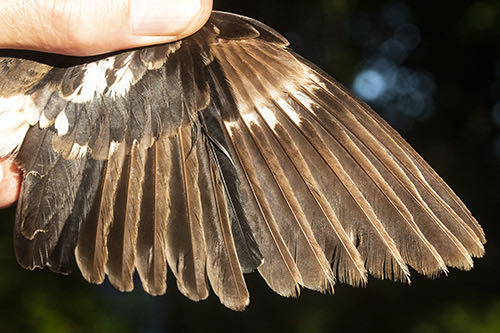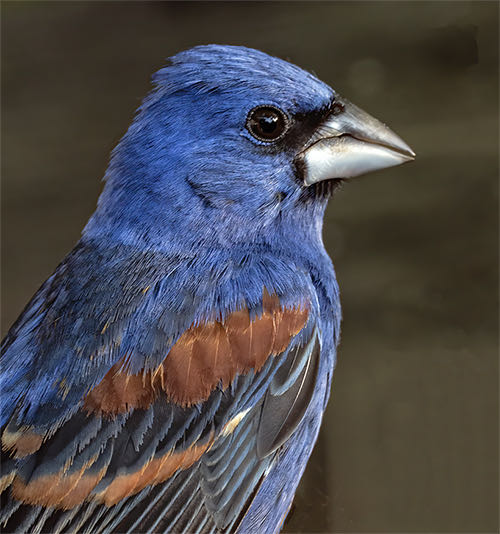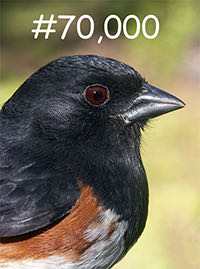- Established 1982 -HOME: www.hiltonpond.org
THIS WEEK at HILTON POND Subscribe for free to our award-winning nature newsletter (Back to Preceding Week; on to Next Week) |
BIRDS OF LATE APRIL 2020 The vernal equinox comes each year on or about 20 March. This designates the end of winter--at least in the astronomical sense--as days start getting longer even if weather isn't exactly springlike. In March, winter resident birds seem content to remain here at Hilton Pond Center for at least another month, and the earliest Neotropical migrants don't often appear locally until the end of April's first week. However, by the time Tax Day arrives mid-month things really start hopping and our banding efforts begin showing wider species diversity. This year (2020) was no exception, and despite the devastating loss of our towering Southern Red Oak during Easter weekend storms, our traps and limited mist nets yielded a satisfying 28 species and 69 individuals during the second half of April. This week at Hilton Pond we thought we'd share images of a few of those late April birds and add some anecdotal info about each.
All text, maps, charts & photos © Hilton Pond Center One of the first migrants to arrive each spring at Hilton Pond Center is the Blue-gray Gnatcatcher (above). Some of these tiny birds probably don't have that far to come since they overwinter along the Carolinas coast, in Florida, throughout Mexico and Cuba, and in Central America as far south as Honduras. Our earliest on record is 9 April, so by month's end local pairs are already well into incubation. (Two of the four we caught this week were a females, each with a well-developed brood patch.) As shown in our photo, the male Blue-gray Gnatcatcher has a distinctive black eyebrow lacking in his mate.
All text, maps, charts & photos © Hilton Pond Center If we can judge by the number of photos posted to Facebook, eBird, and various birding listservs, April 2020 may have been one of the best spring migrations in recent history for Rose-breasted Grosbeaks (RBGR). Folks across the eastern U.S. reported up to a dozen of these big-billed birds hanging out at backyard feeding stations, scarfing up black sunflower seeds by the bucketful. Here at Hilton Pond we captured two older males during April's final fortnight, but several other individuals--including females--were present throughout the period. In our photo above, a second-year male at foreground betrays his age with scalloped back feathers, brown speckles on an otherwise rosy breast patch, and extensive flank streaking.
All text, maps, charts & photos © Hilton Pond Center This time next year that younger, second-year male RBGR will look like the after-second-year adult just above, with pristine plumage and no hints of brown. Decked out in such dapper attire he'll be ready to breed--rarely in the Upper Piedmont of South Carolina, but more likely up the Appalachians and into the northern tier of states and central Canada. [NOTE: The grosbeak above was perched in a fallen limb from the big oak that fell not far outside the kitchen window of the Center's old farmhouse, hence the dead leaves behind him.]
All text, maps, charts & photos © Hilton Pond Center So how is it, you might ask, that in spring a second-year Rose-breasted Grosbeak has brown feathers or flank streaking in the first place? The answer is that at fledging, young male RBGR start out looking much like the female above, all brown and white with streaks. The majority of those first-year males start molting soon after leaving the nest and finish up before they return from their Central American "wintering" grounds (mostly Central America), looking look more or less like adult males in time for their April arrival at Hilton Pond.
All text, maps, charts & photos © Hilton Pond Center A few male youngsters--perhaps those produced from late nests in North America--have a delayed or incomplete "winter" molt and end up looking a little female-like when they show up in spring. Such was the case this April of a second-year male who had retained most of his natal wing plumage; as shown in the photo above, all but one pf his primary and secondary wing feathers were brown and heavily worn. It would be interesting to catch him next spring to see what sort of plumage he might have.
All text, maps, charts & photos © Hilton Pond Center So in autumn, when we capture Rose-breasted Grosbeaks migrating south past Hilton Pond Center, how might we differentiate brown females from immature males that might likewise be brown? It's easy: Just look beneath the wing. Those underwing covert feathers that overlap bases of the grosbeak's flight feathers are yellow in females (above), and rosy pink in males of any age--a field mark sometimes seen at feeders when possessive Rose-breasted Grosbeaks go after each other and spread their wings.
All text, maps, charts & photos © Hilton Pond Center [NOTE 1: With so many spring reports of Rose-breasted Grosbeaks (female above) throughout the eastern U.S., folks have asked what might be going on? Some observers suggest unusual weather patterns this year shifted the regular RBGR migration route--which could indeed be a factor--but we think there's probably more to it than that. Perhaps the species had a very good 2019 breeding season in North America, followed by an unusually successful southbound migration. And maybe there was an abundant food crop in the Neotropics this year, boosting grosbeak survival on the wintering grounds. All these factors could culminate in a successful northbound trip for large numbers of these big-billed birds. But who knows for sure? That's one difficult thing about nature studies; with so many variables out there it's difficult to identify and validate cause-and-effect relationships. No matter the cause, however, we're delighted so many people got to see lots more Rose-breasted Grosbeaks than "normal" in late April 2020.]
All text, maps, charts & photos © Hilton Pond Center Another grosbeak species appeared at Hilton Pond Center in late April, not quite as flashy as the rose-breasted but--to our eyes--nonetheless quite elegant. This was the Blue Grosbeak (BLGR), in which the male (above) is iridescent blue with two rusty wing bars--plus bi-colored mandibles in that typical grosbeak shape. This species is sometimes confused with the Indigo Bunting, which has no rusty feathers and is just two-thirds the size of the BLGR.
All text, maps, charts & photos © Hilton Pond Center The female Blue Grosbeak (above) is one of the more nondescript birds in North America, with overall brown plumage. She does have rusty wing bars--smaller and paler than in males--and often bears a few bluish lesser covert feathers at the bend of the wing. Unlike Rose-breasted Grosbeaks that seldom breed in the Carolina Piedmont, Blue Grosbeaks have nested at or near Hilton Pond. Years ago, not far from the Center we found a BLGR nest parasitized with two eggs from a Brown-headed Cowbird.
All text, maps, charts & photos © Hilton Pond Center Another Neotropical migrant that tends to come back to Hilton Pond Center fairly early in spring is the Gray Catbird (above). This sexually monomorphic species is well-named, being gray overall (with a black cap) and with a variety of cat-like noises in its vocal repertoire. GRCA rarely overwinter in the Carolina Piedmont and appear on Christmas Bird Counts; the vast majority depart for coastal areas all the way from Cape Cod to Panama before returning to the eastern two-thirds of the U.S. to breed. On our Operation RubyThroat hummingbird expeditions to Belize in early March we caught large numbers of GRCA--so many that we joked the country must be a "catbird factory." Gray Catbirds are likewise plentiful during migration and the nesting season at the Center, where we've banded 954 since 1982--our tenth most common species!
All text, maps, charts & photos © Hilton Pond Center Late April certainly wouldn't be late April at the Center without the members of the Wood Warbler Family (Parulidae), one of which actually had been with us all winter. That would be the Yellow-rumped Warbler (above), relatively drab for most of the cold months but now developing its breeding plumage while waiting to fly back north to New England and most of Canada. The bird in our photo is a male, with yellow crown and flank spot and a dark black face and broken white eye ring. Mature females are less colorful overall, with a gray face.
All text, maps, charts & photos © Hilton Pond Center Three more of our late April warblers at the Center--all males--also happened to have black faces. Above, the monochromatic Black-and-white Warbler (BAWW) is another aptly named species that nests locally but typically winters in Central and northwestern South America. This bird's long toes and relatively large bill allow it to cling to tree trunks and probe bark crevices for invertebrates such as insects and spiders. The female BAWW again has a paler cheek patch.
All text, maps, charts & photos © Hilton Pond Center Female Common Yellowthroats (COYE) have no cheek patch at all, but the male (above) has a prominent black mask above the bright yellow throat that names the species. Note also the gray edging along the back of his mask; in our experience this seems wider and brighter in older individuals. COYE is another Wood Warbler that breeds here at Hilton Pond Center; as evidence, we've captured several females with active brood patches. Common Yellowthroats truly are common; they may be the only warbler that breeds in every contiguous U.S. state and all the southern Canadian provinces. (There's even a population that nests in the mountain ranges of Central Mexico.)
All text, maps, charts & photos © Hilton Pond Center Our last dark-cheeked parulid during late April was a male Black-throated Blue Warbler (BTBW, above)--yet another appropriately named species. Note also the large white wing spot, a field mark especially useful in identifying the female BTBW that looks nothing like her mate. (Dorsally she's plain olive-gray with a buffy belly and breast, plus a pale line above the eye; her small white wing spot is the give-away field mark.) Black-throated Blue Warblers nest up the Appalachians into the northeastern U.S.; there are a handful of breeding records from South Carolina's mountain counties.
All text, maps, charts & photos © Hilton Pond Center The Center's final two parulids we're showcasing for the latter half of April were quite different. The one above might be a "confusing spring warbler" for many observers; it's helpful to know this individual has white outer tail feathers, yellow undertail coverts, and no wing bars--and that she could be a local breeder. Note the full yellow face and greenish-yellow cap and you will correctly conclude this is a female Hooded Warbler (HOWA), another species that breeds throughout the eastern U.S., including here at Hilton Pond. The male sports a full black hood and bib, although old female HOWA apparently sometimes exhibit those same characteristics.
All text, maps, charts & photos © Hilton Pond Center And then there was the species above--one of three "streaked brown warblers." The other two are both waterthrushes, so this one must be an Ovenbird, with black head stripes centered by a rusty crown. Chunky, sparrow-sized Ovenbirds--named because they build a covered nest that resembles an old-style outdoor clay oven--breed here in the Upper Piedmont of South Carolina. Even so, we've never found a nest at the Center or captured a breeding female or recent fledgling.
All text, maps, charts & photos © Hilton Pond Center Our next three late April birds are all cavity nesters that occupy old woodpecker domiciles and, upon occasion, use nest boxes provided primarily for some other species. The largest at 7" in length was a true Neotropical migrant that spends our winter in Central America and northwestern South America--the Great Crested Flycatcher (GCFL, above). This is the biggest regularly occurring flycatcher in the eastern U.S. and one that folks hear more often than they see; a raspy "Wheeeep!" is the call. Here at Hilton Pond Center we've had GCFL nesting in tree cavities and, one year, in a Wood Duck box after ducklings had hatched and fledged. What clued us into the flycatcher's presence was an old snakeskin hanging out of the entry hole--the hallmark of many Great Crested Flycatcher nests. A predator deterrence, perhaps?
All text, maps, charts & photos © Hilton Pond Center The second cavity nester of the two-week period was a non-migratory bullet-shaped bird with short tail and a longish, slightly recurved bill: A White-breasted Nuthatch (WBNU, above). This species has been increasing in number at the Center in the past decade or so, likely as hardwood trees have become larger and now have more limbs with snags. WBNU do a little excavating of their own but leave the heavy work to our local Downy and Red-bellied Woodpeckers. (We've never had a WBNU use a nest box at Hilton Pond.) The White-breasted Nuthatch in our photo is a male, based on his jet black cap; this is usually more gray-black in females.
All text, maps, charts & photos © Hilton Pond Center Other than Eastern Bluebirds, the most common occupants of nest boxes we erect at Hilton Pond Center are our year-round resident Carolina Chickadees (CACH). Interestingly, our CACH pairs nest rather early, half-filling a box with soft moss that undoubtedly keeps eggs and chicks warm on chilly days in early April. After chickadee chicks fledge by late April, we remove the soiled nests, after which the now-vacant boxes are often taken over by pairs of Eastern Bluebirds. We doubt CACH would ever re-nest right after their progeny fledge, especially because the each set of parents has 5-7 mouths to feed--even as the youngsters continue to beg for a few weeks before heading out on their own. This year our most productive nest box had seven little eight-day-old Carolina Chickadees we carefully banded (above) and gently put back in their comfy nest so they could complete development. The parents made understandable commotion during the process but immediately returned to their food-toting responsibilities when we finished banding the chicks and closed the box.
All text, maps, charts & photos © Hilton Pond Center It's been an exceptionally slow spring for our main target species at Hilton Pond Center, with only four new Ruby-throated Hummingbirds banded and four returning RTHU recaptured through the end of April. On average we should have a dozen or more banded by now. Last year (2019) also started slowly and we ended up with our lowest total of new ruby-throats: 162, down significantly from 222 the year before and from 298 in 2017. We're hopeful May 2020 will be a little more productive. The hummer above is an adult female we captured this year on 24 April. Although she had just returned from the Neotropics, she was rather tubby at 4.16 grams--more than her expected summertime weight of about 3.5 g. She had some fat on her, which suggests she was still migrating and would not be spending the breeding season here at the Center. [NOTE 2: We color marked the female RTHU above with temporary green dye on her upper breast. Since her band would be very difficult to see, this visble mark minimizes the possibility of continually recapturing her in one of our pull-string traps. It also makes it possible for observers away from Hilton Pond to notice and report our banded ruby-throats--a useful tool in understanding hummingbird migration. If one of these marked hummers visits your feeder, please get a photo and contact us immediately at RESEARCH.] So there you have it, our annotated portfolio of birds observed and/or banded during late April 2020 at Hilton Pond Center. They represent a typical assortment of residents and migrants to be seen locally during early weeks of spring migration, with even more species and individuals to follow during the first half of May. [NOTE 3: Scroll to the bottom of this page for a complete tally of the 28 species we banded at Hilton Pond during the last half of April 2020. There's also a list of some interesting recaptures during the period.] All text, maps, charts & photos © Hilton Pond Center SPRING FUNDRAISER At Hilton Pond Center we were excited on 2 April 2020 to band our 70,000th bird since 1982. Some of you have already helped mark that significant milestone with a donation supporting our initiatives in environmental education, field research, and resource conservation. Now, with the loss in mid-April of our massive Southern Red Oak, including collateral damage to other vegetation To help us get past this latest stumbling block, please consider making a donation through Facebook at the link above. You can also donate via PayPal, at Network for Good, or through the Center's new Venmo account (@Bill-Hiltonjr). Personal checks can be sent to 1432 DeVinney Road, York SC 29745. Since we're a non-profit, all gifts should be fully tax-deductible. Thanks for whatever assistance you can provide as Hilton Pond Center buckles down and continues to move forward as the most active year-round bird banding station in the Carolinas. All text, maps, charts & photos © Hilton Pond Center BIRD BANDING VIDEO For the past 18 springs we've been away from Hilton Pond and at the New River Birding and Nature Festival in Fayette County WV. The video is now available via YouTube on our new channel for Hilton Pond Center for Piedmont Natural History (please subscribe). Hope to see you "there" at this year's on-line Festival. (P.S. The video is a great learning opportunity for home-learning for young people sheltering in place with family.) All text, maps, charts & photos © Hilton Pond Center
Checks also can be sent to Hilton Pond Center at: All contributions are tax-deductible on your Don't forget to scroll down for Nature Notes & Photos, |
|---|
|
"This Week at Hilton Pond" is written and photographed by Bill Hilton Jr., executive director of Hilton Pond Center for Piedmont Natural History
|
|
|
Please refer "This Week at Hilton Pond" to others by clicking on this button: |
|





















 and destruction of mist nets, a
and destruction of mist nets, a  There we lecture, guide, and conduct bird banding workshops for enthusiastic participants from across North America. This year, because of the pandemic, the week-long Festival was canceled and organizers asked us to be part of a virtual Festival instead. On 27 April 2020 we were honored to have the kick-off lecture slot--a 35-minute video of a nature walk and bird banding demo at the
There we lecture, guide, and conduct bird banding workshops for enthusiastic participants from across North America. This year, because of the pandemic, the week-long Festival was canceled and organizers asked us to be part of a virtual Festival instead. On 27 April 2020 we were honored to have the kick-off lecture slot--a 35-minute video of a nature walk and bird banding demo at the 









 Please report your
Please report your